Published materials
This is a small sample of the published materials on display at the exhibition.

A Korao no New Zealand. Sydney: Printed by G. Howe, 1815. W1. Hocken Library: Williams Collection.
This elementary primer was compiled by the Church Missionary Society (CMS) lay teacher Thomas Kendall in the Bay of Island and sent to Rev. Samuel Marsden (then in Sydney) for printing in 1815. It is the first separately published work devoted to the Maori language. In his attempt to standardize orthography, Kendall initiated the Italian or open vowel system, inserted accent marks for long vowels, and established later the ng (1820) and wh (1832) consonants. The only known surviving copy (of 200) is held at the Auckland War Memorial Museum. The Hocken Library has the limited edition facsimile copy (1957) and this unique copy transcribed by hand by John Kenderdine, an Auckland chemist and book collector.
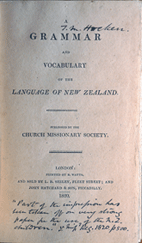
A Grammar and vocabulary of the language of New Zealand. London: Printed by R.Watts, 1820. W3. Hocken Library: Williams Collection.
Thomas Kendall compiled this grammar and vocabulary under the direction of Professor Samuel Lee, oriental linguist, at Cambridge, England, in 1820. Kendall was assisted by Hongi Hika and Waikato, two Maori chiefs who had accompanied him to England. This work was a huge advance: the initial and medial d was retained, a fixed value was given to the vowels (a system devised by John Davies for Tahiti), and consonants and a wide group of syllables were collected. Some 750 copies were printed.
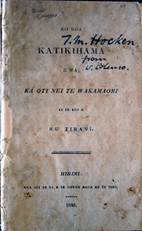
Ko nga Katikihama e wa. Hirini (Sydney), 1833. W10. Hocken Library: Williams Collection.
Twelve printed Maori language items are unique to the Hocken Library. This is one, a work that contains four catechisms: I-II - two composed by Rev. William Yate at Kerikeri; III - a translation of Isaac Watts's 'principles of religion' and 'scriptural names' (with questions from the Old and New Testaments); and IV - the Church Catechism, first printed in 1830 as Ko te Katekihama III. William Colenso noted its rarity on a preliminary page: 'Interleaved by me, for use in visiting, and in schools - perhaps the only copy existing! - always for 60 years, very scarce.'
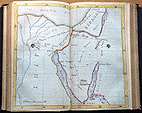
o te tahi wahi o te Kawenata Tawhito : Ranana (London), 1848. (Bible, O.T, Maori) W167. Hocken Library: Williams Collection.
A print run of 10,000 copies of the Hexateuch (the first six books of the Old Testament: Genesis to Joshua) was arranged by the British Foreign Bible Society (BFBS), half each given to the CMS and Wesleyan missions. Copies were seen through the press by John Telford, but an illness resulted in Edwin Norris, the English philologist and expert in cuneiform, taking over the responsibility. This copy was given to Tamihana Te Rauparaha on the occasion of his visit to London in 1851. The map of the Red Sea map has been tipped in.
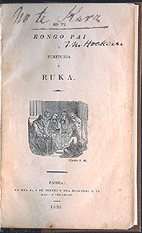
Ko te Rongo Pai i tuhituhia e Ruka [Luke]. Paihia, 1835. W17. Hocken Library: Williams Collection.
In spite of poor equipment and the lack of good stationery, William Colenso's early print productions were a considerable achievement. His first work was a 16 page translation into Maori of the Epistles of Paul to the Philippians and to the Ephesians, which appeared on 17 February 1835. His second (here on display) was the Gospel of Luke, translated by the Rev. William Williams. Demand for copies were high, with the price paid for each copy being three bushels of potatoes (Williams to Jowett, 6 January 1836). Colenso's output attracted great Maori interest and certainly increased the authority and extent of missionary influence.
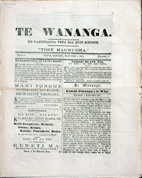
Te Wananga, 5 Hanuere (January) 1878. Williams Collection, W. 504, Hocken Library.
Te Wananga (The Forum) was 'owned, printed and published by Maori' and carried in its columns news, information on land transactions in the Hawkes Bay, grievances, and possible means of redress. The driving force behind the paper was Karaitiana Takamoana and Henare Tomonana, and for most of the newspaper's life (179 issues: 5 August 1874 to 21 December 1878), it was financed by Henry Russell. In general_items it was a bitter opponent of the government-sponsored Te Waka Maori o Niu Tirani (The Maori Canoe of New Zealand).While no Maori newspaper was established in the South Island, this particular issue details a letter towards such an initiative. The letter is signed by Mathia Tiramorehu, Rawiri Temamaru and five others.
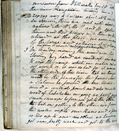
James Hamlin, Diary 1830-1832. MS 0560, Hocken Library.
The Revd. James Hamlin co-founded the Waimate Mission Station in 1830. In between writing up sermons and undertaking maintenance work (repairing and painting windows), he traveled throughout the region, exploring the countryside. On display are entries for an expedition begun on 26 November 1832 from Kerikeri and which ended a few weeks later at Mangonui. On this trip, Hamlin was accompanied by Mr (Henry?) Williams, Mr Baker, William Puckey, Mr (Rev Joseph?) Matthews, and thirty-six local Maori. Hamlin left the north for Puriri (Thames) in 1834.
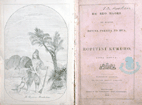
Daniel Defoe, The Life and Adventures of Robinson Crusoe. Wellington: Printed at the 'Independent' Office, 1852. W.243, Williams Collection, Hocken Library.
Daniel Defoe's classic tale, first published in 1719, was translated into Maori by H.T. Kemp. It contains four specially prepared illustrations (lithographs) by Dr T. S. Ralph. The translation was instigated by Sir George Grey, who considered the work would be 'useful and interesting' to Maori. According to William Swainson, Maori readers preferred the story of 'Peter the Great' over Robinson Crusoe because the latter was not true.
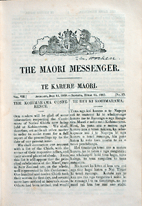
Proceedings of the Kohimarama Conference, in The 'Maori Messenger' Extra, 3 August 1860. Auckland: W.C. Wilson, 1860. W.317, Williams Collection, Hocken Library.
Over July and August 1860, 200 Maori chiefs attended a conference held at the Melanesian Mission at Kohimarama, Auckland. It was an important gathering, where issues such as the Taranaki War, the Kingitanga, disputes over land, the provision of justice, and the Treaty of Waitangi were discussed. This parallel English-Maori edition was reissued from five issues of the Maori Messenger (14 July-30 November 1860). Here there are speeches from Paora Tahaere (Ngati Whatua, Orakei), Wiremu Tamihana Te Neke (William Thompson), and Tamihana Te Rauparaha.
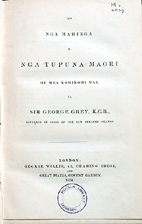
Sir George Grey, Ko Nga Mahinga a Nga Tupuna Maori. London: George Willis, 1854. W.260, Williams Collection, Hocken Library.
Tupuna Maori contains 31 Maori legends of cosmological, mythological and historical significance in three parts (wahi). Although an important publication, it was the English language edition of Polynesian Mythology, published a year later, which gained a much wider readership and promoted things Maori. The preface of the English edition revealed Grey's notions on the collecting of indigenous languages: 'I felt unwilling that the results of my labours should be lost…' and it was completed with the 'same sense of duty which made me originally enter upon the study of the native language.'
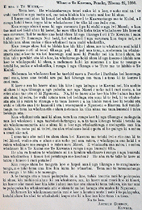
Letter from Governor Arthur Gordon to Te Whiti, 22 November 1880. [Wellington, 1880]. W.595.Williams Collection, In Variae 18, no.44, Hocken Library.
This is a letter from Governor Sir Arthur Gordon (recently arrived in New Zealand) to Te Whiti-o-Rongomai III, the Taranaki leader and prophet, inviting him to meet and discuss the grievances about the loss of lands. Gordon asks that Te Whiti put it all in writing beforehand. This document, facing the specimen page of William Colenso's Maori-English Lexicon (1882) is unique to the Hocken Library.


